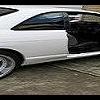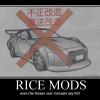Cryogenics
Announcements
-
Latest Posts
-
Ok, just the way you wrote it made it look like you had the stagger the wrong way around
-
By hoodedreeper · Posted
I was getting anxious with the DVLA not knowing if the paperwork is fine or not, so I rang them. No update had been given, but I was reassured that providing the box was ticked on the V750 then the application will go through fine. I've been checking the DVLA website pretty much every day, in the hope that it would have been done. Fast forward to Monday 29th and I was greeted with a new screen on the check, and it finally showed as Taxed and MOT'd, woohoo! The car was in desperate need of a clean, not knowing when this day was coming it was put off. As far as I was concerned I had another 3 weeks I'm not normally one for using snow foam, but I wanted to give it another try It hasn't cleaned up too bad considering it's 21 years old and lived on a boat for a number of weeks. The personalised number plate is J2 XBK, an illegally spaced number plate would have it read J2X BK. BK could either represent the colour black or Baker, which is my surname. I filmed the first drive, the Youtube link will be at the end. I used the same driving route I did with the 323F V6 when I had a new exhaust installed, heres a couple of photos A few more since then Youtube video can be viewed here: https://www.youtube.com/watch?v=TjkFHPzjGDw -
By TurboTapin · Posted
Kelford 246-A2. 262in/272ex. -
By Adam_ECR33 · Posted
Thank you, 100% the intent. New coils were due and the 17" sixers look/feel loads better than the stock wheels. The aero options are so spot on. Thanks for the warm welcome, all! -
98 r34 gtt Been rocking my latest setup and car running like never before. Have put a good 200 miles on it since all the latest changes and additions. everything is dialed in and have been driving it a bunch. However, all a sudden last weekend as soon as I pushed throttle passed 4k and the engine stumbles, (slow or fast acceleration) hesitates and doesn’t go above 4100 or so, like a misfire. Everything else seems fine. I had a “good” set of coil packs that I removed from car when I first got it when I changed them over to new coils. I swapped out current ones for those, but no change. I also changed the plugs, no change. Seems to rev over 4 when out of gear with no load just fine no “misfire”, but as soon as its in gear with a load of any kind, it “misfires” as soon as rpm drop back below 4 k it runs perfectly, smooth, starts, restarts and drives fine as long as I keep it below 4 k while in gear. All readings look fine, no CEL Any idea as to what could all a sudden cause an issue when pushing rpms passed 4 k?
-




Recommended Posts
Create an account or sign in to comment
You need to be a member in order to leave a comment
Create an account
Sign up for a new account in our community. It's easy!
Register a new accountSign in
Already have an account? Sign in here.
Sign In Now